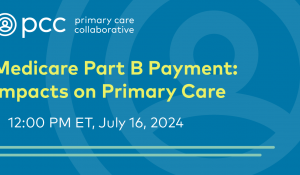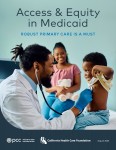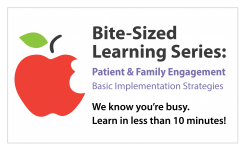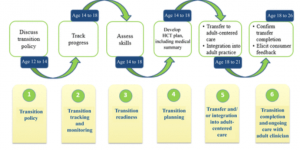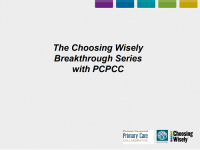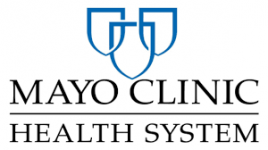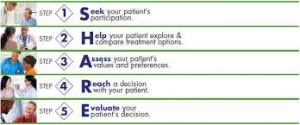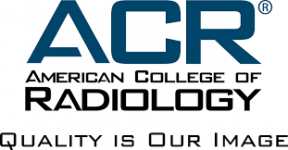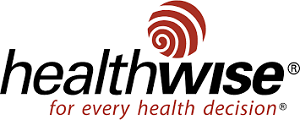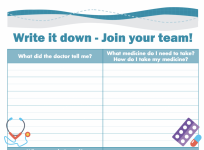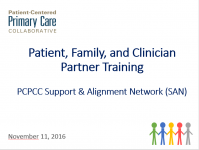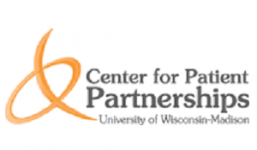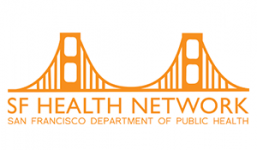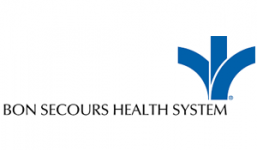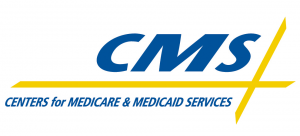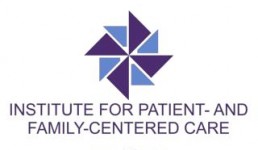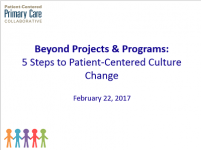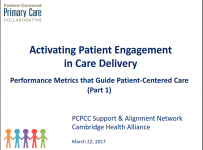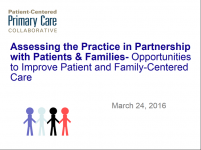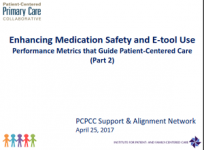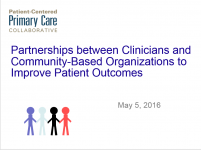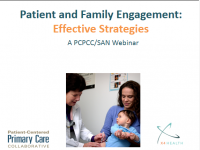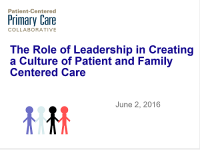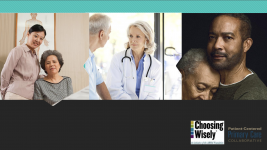Transformation Resources
Robust Primary Care is a Must
August 2023 - PDF
"Access & Equity in Medicaid: Robust Primary Care is a Must"
Read PCC’s report that reviews the evidence to identify eight primary care payment and delivery reform strategies to improve access, outcomes, and equity for Medicaid recipients.
v3 pcc-...
November 2019 -
This concise list of recommendations lays out a clear path to intergrating behavioral health and primary care. By involving the full healthcare team, we can more appropriately leverage behavioral health resources to meet those in need.
November 2019 - PDF
Parents Available to Help (PATH)/ Family Voices of Connecticut's peer support program helps empowers families to advocate for the best care for their children and reaffirm their value as parents and caregiviers. Learn more about their impactful work in the attached Parent to...
November 2019 - PDF
The Yakima County Parent to Parent program offers emotional support and information to families raising children with special health or developmental needs. In addition to parent support, the program offers sibling support, recreation and social opportunities, a newsletter, and...
November 2019 - PDF
Family Voices of Tennessee, a program of the Tennessee Disability Coalition, provides emotional and educational support to the families of these children. To reach these families on what can be a lifelong, complex healthcare journey with their child, Family Voices of Tennessee...
CMS
October 2019 - Website
The go-to resource for latest updates and background information on the Quality Payment Program (QPP) from the Centers for Medicare and Medicaid Services (CMS).
YMCA of the USA
October 2019 - Website
The Y is partnering with clinicians at the local level in order to help individuals prevent, delay, or live better with chronic conditions. Read more about their programs, including their Diabetes Prevention Program.
Community integrated health is the effort to strengthen the...
University of Boston, U.S. National Library of Medicine, CommunicateHealth, Inc.
October 2019 - Assessment, Website
This website includes over 100 health literary assessment tools. Numerous search filters are available, including specific context/disorder.
Choosing Wisely, ABIM Foundation
October 2019 - PDF, Template, Video, Website
These downloadable resources can be used by clinicians to educate patients about Choosing Wisely, which helps patients ask questions and make informed decisions. Several of these items can be placed in waiting or exam rooms or given to patients as handouts.
American Academy of Pediatrics
October 2019 - Website
The American Academy of Pediatrics has created a resource directory for advancing the medical home model and practice transformation.
American Academy of Pediatrics
October 2019 - Website
The National Resource Center for Patient/Family-Centered Medical Home Is a national technical assistance center focused strengthening the system of services for children and youth with special health care needs and their families by enhancing the patient/family-centered medical...
Get Started Here! PCPCC Bite Size Learning Modules
October 2019 - Learning Module
Patient and family engagement strategies in 10 minutes or less. Six learning modules serve as a "starter track" for primary care practice transformation.
University of North Carolina at Chapel Hill
October 2019 - Website
Resource bank to help primary care providers and practices promote and integrate peer support. Some are available in Spanish.
IPFCC
October 2019 - Website
The IPFCC has created a resource bank for effectively engaging patients and families in research projects.
Institute for Healthcare Improvement
October 2019 - Brochure, Poster, Template
Brochures and posters about Ask Me 3® -- an educational program that encourages patients and families to ask three specific questions of their providers to better understand their health conditions and what they need to do to stay healthy.
Patient Portals: How can they impact primary care?
September 2019 -
Patient portals are becoming more prevalent, as healthcare providers, payers, and patients become more comfortable with their use. A 2017 survey found that 82% of patients reported having logged into their provider’s patient portal at least once – a drastic change from a similar...
Choosing Wisely, IPFCC, PCPCC
October 2018 - Action Plan, PDF
This guide outlines how practices can involve patient and family advisors in the Choosing Wisely implementation, which helps patients ask questions and make informed decisions.
American Academy of Pediatrics
October 2018 -
This peer-reviewed report on health care transition for pediatric to adult health care includes a process for transition preparation, planning, tracking, and follow-through and is based on more than two decades of evidence-based research. A special focus is placed on young...
Developed by Health Innovation Program University of Wisconsin School of Medicine & Public Health
Health Innovation Program, University of Wisconsin, Wisconsin Network for Research Support
September 2018 - Learning Module, Template, Toolkit, Video
The toolkit contains educational materials and training templates for effectively engaging patient advisors in research projects. Materials can be tailored for each research project.
May 2018 -
Choosing Wisely is a leading effort to encourage conversations aimed at reducing unnecessary tests and treatments in health care.
Maine Quality Counts, PCPCC
April 2018 - PDF
This document outlines how the Choosing Wisely program can help practices achieve TCPI program aims, which align with the Quality Payment Program.
Northern New England Practice Transformation Network
April 2018 - PDF
This document outlines how patient and family engagement activities can improve health outcomes and achieve TCPI program-specific metrics, which align with quality payment program standards. Links to additional resources for a deeper dive are also provided.
Military Heath System
Military Heath System
April 2018 - Learning Module, Video
Five modules and links to a wide-range of resources for moving patients forward on the patient activation continuum. The tools are listed by category, and include Activation, Communication, Decision Aids, Self-Management and Shared-Decision Making.
AHRQ
April 2018 - Learning Module, PDF, Template, Toolkit, Webinar, Website
This comprehensive guide provides primary care practices with four strategies that they can adopt to improve patient safety and engagement.
Rural Health Information Hub
April 2018 - Learning Module, Website
The toolkit is designed to help rural communities identify and implement a care coordination program. It also provides links to resources and best practices.
U.S. Department of Veterans Affairs
Shared Decision Making Worksheet
March 2018 -
Shared Decision Making (SDM) is a collaborative, patient-directed decision making process that helps Veterans, together with their family caregivers and health care team, set goals and priorities, and make choices that meet patient needs while honoring patient values and...
Mayo Clinic
March 2018 - Checklist, Guide, PDF, Toolkit
The Mayo Clinic Shared Decision Making National Resource Center provides decision aids and decision-making techniques. Tools are available for specific conditions and in English and Spanish.
Families USA
Patient Decision Aid
March 2018 -
Fundamentally, shared decision making is about giving patients the opportunity to be active participants in their health care. When well-informed patients and caregivers team up with health professionals who are trained in effective communication, patients are more likely to...
AHRQ
March 2018 - Learning Module, Video, Webinar
AHRQ’s SHARE Approach is a five-step process for shared decision-making. Fact sheets, learning modules, videos, success stories, webinars and marketing materials are available.
Radiological Society of North America, Inc. (RSNA)
March 2018 -
This site contains information for patients to prepare for radiation exams, therapies or procedures. There are over 230 procedure, exam and disease descriptions available.
American College of Radiology
March 2018 - Website
Guidelines for which imaging tests providers should, or should not, order for different patient symptoms, medical histories, and health status. The recommendations are reviewed every year using an expert panel.
National Quality Forum
Shared Decision Making Fact Sheet
March 2018 -
The National Quality Forum is issuing a call to action for all individuals and organizations that provide, receive, pay for, and make policies for healthcare to embreace and integrate shared decision making into clinical practice as a standard of person-centered care.
Healthwise Website
March 2018 -
Uncover the Voice of Patients With Shared Decision Making
AMA Steps Forward Module
American Medical Association, AMA Steps Forward
March 2018 - Learning Module, Video
This learning module reviews common causes of medication nonadherence and how your practice can establish a standrd process to address them. 0.5 CME credits from the AMA are available upon completion.
Developed by the University of Wisconsin
Patient and Family Engagement Resources
March 2018 -
This webiste includes toolkits for evidence-based health system and population health improvement.
Lessons from AF4Q
PFE Toolkit
March 2018 -
This toolkit showcases how primary care practices are involving patients in quality improvement efforts as part of Aligning Forces for Quality (AF4Q), the Robert Wood Johnson Foundation’s signature effort to lift the quality of care in targeted communities across the United...
Video: MedStar
Tips on Starting a Patient and Family Advisory Council for Quality & Safety
March 2018 -
National leaders in patient advocacy, also members of the MedStar Health Patient and Family Advisory Council for Quality and Safety (PFACQS), provide tips on what it takes to start a PFAC that focuses on Quality and Safety
AHRQ
March 2018 - Action Plan, Checklist, PDF, Template, Toolkit
The Quick Start Guide provides clinicians and practice staff with five simple steps to implement a medication management strategy in the office setting.
AHRQ
March 2018 - Assessment, Toolkit
The Quick Start Guide provides clinicians and practice staff with five simple steps for implementing the teach-back approach in the office setting.
American Medical Association, AMA Steps Forward
February 2018 - Learning Module, Template, Video
Learning module highlighting steps for developing and implementing health coaching models within practices offered by American Medical Association STEPS Forward. Participants can earn 0.5 CME Credits.
AHRQ
October 2017 - PDF
The Quick Start Guide provides clinicians and practice staff with five simple steps for implementing the warm handoff strategy in the office setting, and resources to encourage patient participation.
AHRQ
October 2017 - Video, Webinar
This webinar provides an overview of the Warm Handoff Strategy and how to implement it within primary care clinic settings.
National Academy of Medicine
October 2017 - Website
This report outlines evidence-based strategies to facilitate a patient and family engagement framework within primary care practices.
AHRQ
October 2017 - Checklist, Guide, Website
The Be Prepared To Be Engaged toolkit will help patients and their families prepare for and become more fully engaged in their medical appointments—to be ready for the appointment, to speak up, to ask questions, to take notes. Tools are also available for clinicians and practice...
AHRQ
October 2017 - PDF
Tool for patients to effectively record discussions, decisions made and follow up items from an appointment.
PCPCC
October 2017 -
This document guides the creation of a six-step action plan for collaboration with patients and families in primary care practices or Practice Transformation Networks (PTN).
PCPCC
September 2017 - Learning Module, Video
Five recorded learning network calls lead by a pediatric quality improvement expert showcasing pediatric practices that have improved asthma care quality, and links to supplemental resources (some in Spanish).
Guide to Partnering with Your Clinic
PCPCC
June 2017 - Template, Toolkit, Video
About this Guide:
When patients and families build partnerships with their health care team – such as doctors, nurse practitioners, nurses and clinic staff - to improve health care, everyone benefits! This guide will help you decide if you want to partner with your health...
American Academy of Pediatrics, National Resource Center for Patient/Family-Centered Medical Home
May 2017 - PDF
This document provides practical tools, resources, and strategies to test different patient and family engagement approaches and determine the best fit for your primary care practice.
Developed by the PCPCC Support & Alignment Network
PCPCC
April 2017 - Toolkit
This toolkit outlines six steps for creating a practice culture that emphasizes and incorporates the patient and family perspective in every aspect of care, and a 30-day kick-start plan maps out concrete actions that can be taken within the next month.
Materials from November, 2016 PCPCC Support and Alignment Network Training Session
PCPCC
November 2016 - Presentation
In November 2016, PCPCC offered a special one-day training for patient advisors, family caregivers and their clinician partners. This page contains presentation slides from the sessions, and highlight tools and strategies for implementing patient and family engagement strategies...
American Medical Association, AMA Steps Forward
October 2016 - Learning Module, Template
This learning module provides an overview of Patient and Family Advisory Councils and outlines the steps for creating one. A number of templates councils can use are provided, and 0.5 CME credits are available upon completion.
IPFCC
October 2016 - PDF, Presentation
These presentation slides contain an overview of the history and positive impact of patient and family engagement within primary care practices and examples of successful patient and family advisory councils.
Planetree, PCPCC
October 2016 - Webinar
This webinar highlights the imporance of strong leadership principles when engaging patients and familes in practice transformation.
Planetree
October 2016 - Guide, Template
The Patient Preferences Passport is a user-friendly tool patients can use to take ownership of their care. Additionally, the guide outlines how to effectively implement the tool in practice settings.
Health Innovation Program, University of Wisconsin
August 2016 - Toolkit
This tool is intended to help healthcare organizations improve patient engagement in care redesign. It contains customizable tools and templates for teams and patients working together on quality improvement initiatives. Free registration is required to use the toolkits provided...
San Francisco Department of Public Health
June 2016 - Template
Below are resources from seminars and trainings, for PAC staff, leaders, and patient advisors at San Francisco Health Network Primary Care. Find more additional information here!
Planetree
June 2016 - Assessment
This document can be used for self-reflection across a number of important principles of leadership and patient-centered care.
New Jersey Pediatrics
May 2016 - PDF
This article includes lessons learned, best practices and suggested ways pediatricians can foster these partnerships to enhance outcomes for the children they care for and their families.
Resources from the Bon Secours Virginia Health System
Bon Secours Virginia Health System
May 2016 - Guide, Presentation, Template
Turn-key implementation guide and presentation slides to start a patient and family advisory council.
CMS
March 2016 - Website
This change packet was originally created as a guide for practices participating in the Transforming Clinical Practies Initiative. It outlines tangible steps to meet TCPI goals, which align with Quality Payment Program standards.
Institute for Patient- and Family-Centered Care
March 2016 -
Institute for Patient- and Family-Centered Care
February 2016 -
We believe that working with you to improve care at our practice will make the changes made better meet the needs of all our patients and their families. We invite you to consider becoming a Patient or Family Improvement Partner. Sharing your ideas, experience, and opinions...
Institute for Patient- and Family-Centered Care
February 2016 -
This is a template that your practice, clinic, or hospital can use to engage patient and family advisors.
American Institute for Research, Gordon and Betty Moore Foundation
October 2015 - Action Plan, PDF
This easy to use, interactive PDF contains a vision for patient and family engagement in health care, a set of 8 change strategies, tactics and milestones and simple actions to take today.
National Academy of Medicine Patient & Family Council Leadership Network
October 2015 - PDF
This comprehensive document contains programs, practices and research to support the integration of patient and family engagement, and specific strategies for Patient and Family Advisory Councils.
PCPCC
October 2015 - Presentation, Template
Two slide decks that can be customized for presentations about the patient-centered medical home (PCMH) describing what it is, why it is effective, and program outcomes.
Qualis Health
October 2014 - Video
Transformational improvement in our healthcare system needs to be informed by the voice of the customer. Learn from national expert Christine Bechtel about the value of engaging patients and families in this quick 5-minute video.
The King's Fund
October 2014 - Guide
A comprehensive look at the evidence and strategies for using patient activation to improve health outcomes and patient experience.
Emmi
October 2014 - Video
This four minute video provides a overview of the Patient-Centered Medical Home, and how it can improve our healthcare system for both patients and providers.
American Hospital Association, Health Research & Educational Trust
October 2013 - PDF
This guide provides strategies for leaders to promote culture changes in patient and family engagement. While hospital focused, it is applicable to ambulatory practice.
Annals of Family Medicine
October 2013 - PDF
This study followed 12 high-performing medical home practices for 7 years and identified four shared characteristics.
July 30, 2019
The webinar provides practical ideas for incorporating patient and family perspectives within small practices.
February 4, 2016
Tools/Handouts
Getting Started Guide for Ambulatory Care Patient/Family Partnerships
Patient and Family Partner Roles & Job Descriptions
Partner Application Form
Sample Patient-Family Advisor Confidentiality Form
Overview
How do I go about inviting a patient to...
September 12, 2019
This webinar shares insights from focus groups on communicationg about overuse with patients, research on safety net settings, and information about tools and resources.
Hosted by the PCPCC Support and Alignment Network
February 22, 2017
Creating and sustaining an organizational culture of patient-centered care goes beyond the implementation of discrete projects and sporadic involvement of patients and families.
Indeed, culture is so much greater than the sum of individual efforts and initiatives. It is WHAT...
Activating Patient Engagement in Care Delivery: Performance Metrics that Guide Patient-Centered Care
Hosted by the PCPCC Support & Alignment Network
March 22, 2017
Practices participating in the Transforming Clinical Practice Initiative (TCPI) are constantly aiming towards effective transformation through the implementation of meaningful person-centered care. In support of this goal, TCPI recently released Person and Family Engagement (PFE...
Co-hosted by the Institute for Patient-and Family-Centered Care
May 3, 2018
This webinar provides an overview of Peer Support services, highlights an organization actively connecting families of children with special needs, and reviews a number of resources available for clinics and families.
March 24, 2016
Tools/Handouts
Waiting room observation feedback form
Partnering with Patients and Families: An Ambulatory Self-Assessment
How to conduct a "walk-about" in primary care from the patient and family perspective
Partnering with patients and families in primary care...
Hosted by the PCPCC Support & Alignment Network
April 25, 2017
What activities "count" towards meeting the PFE Performance Metrics and how can you reach these goals without adding more to your plate? We've got answers!
Join us for Part 2 in our series on PFE Performance Metrics as we present a comprehensive overview of Medication...
September 21, 2018
If you are interested in learning more about how peer support can help your practice, please join us at Virtual Peer Support Meeting (PFCC.Connect) on September 27, 2018, at 1:30 PM EST by registering here.
PCPCC, YMCA of the USA, American Medical Association
May 5, 2016
This webinar demonstrates how community-based organizations can partner with primary care providers and clinics on population health initiatives to improve health outcomes, using the Y-USA’s Diabetes Prevention Program as an example.
Hosted by the PCPCC Support & Alignment Network
May 25, 2017
Addressing a person's physical and behavioral health is vital for positive health outcomes and cost-effective care. Integrated care is an effective model because it houses primary care and behavioral health services in one setting. This model also supports a team-based approach...
X4 Health, PCPCC
May 31, 2017
In this webinar, patient and family engagement experts connect the TCPI Metrics with improvement activity requirements of the CMS Quality Payment Program.
January 10, 2019
PCPCC Support and Alignment Network hosted an online discussion with practices who have implemented the ABIMF Choosing Wisely program on Jan 10, 2019 1:00 PM EST. The objectives of this webinar are the following:
• Understand the background and goals of the ABIM Foundation’s...
Hosted by Planetree
June 2, 2016
Overview
Engaged and committed leadership has emerged as an essential element for driving the practice transformation outlined in the TCPI change package. But what does “engaged and committed leadership” look like day-to-day in the office? What leadership behaviors and...
Co-hosted by YMCA of the USA
June 21, 2017
Successful practice transformation requires the adoption of broad population health strategies. Community-based organizations can play an integral role in this arena. As providers accept more risk under value-based payment models, there is a greater emphasis on managing chronic...
January 24, 2019
Exploring Peer Support in Ambulatory Care - Lessons from the Field
Thursday, January 24, 2019 | 12:00 p.m. – 01:00 p.m. Eastern Time
PCPCC presented a virtual panel discussion to learn valuable lessons from various peer support programs in healthcare and gain insights from...
March 14, 2019
This webinar covers factors facing conversations about overuse with patients and caregivers, and provides specific tools and strategies for improving the outcome of those conversations.
March 20, 2019
This webinar shared the story of a Patient Advisor and practice representative who worked together on health literacy issues within their primary care clinic. Attendees also shared their experience and perspectives and asked engaging questions.
Hosted by the Center for Patient Partnerships
July 27, 2016
This webinar, co-hosted by the Center for Patient Partnerships, reviews the advent of patient experience as a vital measure of health care quality, and highlights innovations designed to elicit patients’ stories about health and health care with more narrative richness than...
Foster Conversations with Patients for Better Decision-Making
May 9, 2019
This webinar features stories from patient advisors about their experiences collaborating with practices to implement the Choosing Wisely Program.
June 13, 2019
This webinar shares how Kaiser Permanent Georgia implemented the Choosing Wisely program regionally through 25 medical offices in 14 counties.
Hosted by HealthTeamWorks
September 21, 2016
The PCPCC SAN and HealthTeamWorks have joined forces to present a webinar that will focus on meaningful patient engagement in transformation using a blended model to inform and improve progress toward the Quadruple Aim. Patient experience surveys at the corporate and practice...
Hosted the PCPCC Support & Alignment Network
April 20, 2018
Hosted by the PCPCC Support & Alignment Network, this webinar will:
1. Explore Choosing Wisely as a strategy for improving care and enhancing patient and family engagement.
2. Learn how implementation of Choosing Wisely effectively engages patients at the point of care and...
Hosted by the Institute for Patient- and Family Centered Care and VHQC
September 28, 2016
In partnership with the PCPCC SAN, the Institute for Patient- and Family-Centered Care (IPFCC) offers technical assistance/programmatic support around patient engagement to Practice Transformation Networks (PTN) in TCPI. Support given through in-person trainings, online...
Displaying 1 - 99 of 99
Filter Resources
Secondary menu
Copyright © 2024 Primary Care Collaborative


